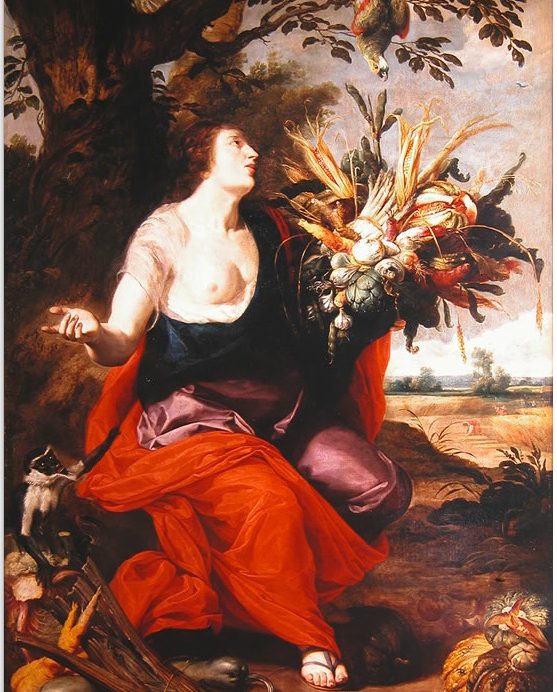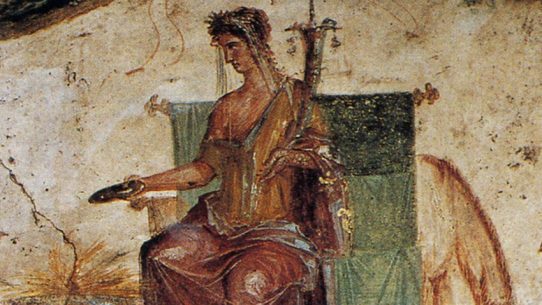Ceres, the revered goddess of agriculture, grain, and motherhood, stood at the heart of Roman life. She governed the cycles of growth, fertility, and nourishment that sustained both land and people.
To the Romans, she was more than a provider of crops — she was a divine mother whose gifts made civilization possible. Every loaf of bread, every field of wheat, and every harvest festival honored her gentle power.
Ceres embodied the bond between earth and humanity, teaching respect for nature’s rhythms and gratitude for its abundance.
Name and Origin
The name “Ceres” is rooted in the Indo-European word for “to grow” or “to create,” reflecting her role as nurturer of life.
She was one of the oldest deities in Roman religion, long venerated before her identification with the Greek Demeter. While Demeter’s myths influenced her later stories, Ceres retained a distinctly Roman identity — practical, moral, and deeply tied to community life.
Her worship reflected the Roman values of labor, family, and gratitude, with rituals that celebrated sowing, reaping, and the fertility of both soil and home.
Attributes and Symbols
Ceres was portrayed as a matronly woman crowned with wheat or poppies, carrying a torch, a basket of fruit, or a sheaf of grain. Her sacred animals included the pig and the snake, both symbols of fertility and renewal.
The torch represented her search for her lost daughter, while the sheaf symbolized the eternal cycle of life and death through the seasons. Her imagery appeared on coins, temples, and altars, reminding Romans that sustenance and civilization were divine gifts born of her care.
Family and Relationships
Ceres was the daughter of Saturn and Ops, and the sister of Jupiter, Neptune, and Pluto. Her beloved daughter was Proserpina, whose abduction by Pluto defined much of her mythology.
Ceres’s grief over the loss of her child caused the world’s crops to wither, bringing famine to humankind. Only when Proserpina was allowed to return for part of each year did fertility return to the land. Their reunion each spring symbolized the renewal of life, while their separation explained the dormancy of winter. This bond between mother and daughter became one of the most powerful symbols of love, endurance, and rebirth in Roman religion.
Myths and Stories
The most famous tale of Ceres is that of her search for Proserpina. When her daughter was taken to the underworld, Ceres wandered the earth, her torches burning through the night as she sought her lost child. In her sorrow, she neglected her divine duties, and crops ceased to grow.
Mortals starved, and the gods feared the extinction of humankind. At last, Jupiter intervened, commanding Pluto to release Proserpina — but because she had eaten the seeds of the pomegranate, she was bound to spend part of each year below. This story, retold by poets such as Ovid, expressed the eternal rhythm of loss and renewal: the descent of seed into earth and its return as new life.
Other legends tell of Ceres teaching early Romans the arts of plowing, sowing, and storing grain. She rewarded diligence and condemned greed, ensuring that farmers honored the earth’s balance. In her wisdom, she also protected marriage and motherhood, connecting the fertility of the soil to that of the family.
Through her myths, Romans learned that nature and morality were intertwined — that abundance was born of harmony, and that gratitude sustained both gods and mortals.
Domains and Powers
Ceres ruled over agriculture, fertility, motherhood, and the sacred bond between humans and the land. Her power extended to every stage of growth — from seed to sprout, from harvest to renewal.
She governed the sustenance of the people and the moral order that maintained prosperity. As patroness of farmers, she was invoked for rain, fertility, and successful harvests. Her presence was felt not only in fields but in the hearth and granary, where families offered her the first fruits of their labor. In every grain that sprouted, Romans saw the living breath of Ceres.
Philosophy and Moral Influence
To philosophers, Ceres represented nature’s generosity and the divine order of life. She taught moderation, gratitude, and respect for the cycles that sustain existence.
Her myths embodied the truth that creation and loss are inseparable — that renewal is born from decay. Ceres’s maternal compassion reflected Rome’s highest ideals of care and duty, while her wrath in famine warned of the cost of neglecting nature’s gifts.
Stoic thinkers saw her as the embodiment of providence, the guiding principle that nourishes all life. In her, wisdom took the form of patience and stewardship.
Temples and Worship
The worship of Ceres was central to Roman religion. Her most famous temple stood on the Aventine Hill, shared with Liber and Libera, deities of fertility and freedom. Established in 493 BCE, it became a major center for the plebeians, Rome’s common people, who viewed Ceres as their protector.
Festivals dedicated to her included the Cerialia, celebrated each April with games, offerings, and races honoring the return of Proserpina and the renewal of the earth. During the rites, foxes with burning torches tied to their tails were released into the Circus Maximus — a symbolic act of purifying the fields with fire.
Farmers prayed to Ceres for bountiful harvests and offered her the first sheaves of grain as thanks for her blessings.
Legacy and Cultural Influence
Ceres’s influence extended well beyond antiquity. In the Renaissance, she was revived as a symbol of abundance and natural order, appearing in art and literature as the archetype of the nurturing mother. Her name endures in the word “cereal,” a lasting tribute to her dominion over grain.
The Roman devotion to Ceres helped shape Western ideas of agriculture, community, and sustainability. She remains a timeless emblem of fertility and gratitude — the divine reminder that prosperity begins in harmony with the earth.
Unique Traditions and Notes
Before every harvest, Roman farmers performed rituals in Ceres’s honor, offering milk, honey, and wine. Women prayed to her for fertility and safe childbirth, believing her blessings strengthened both womb and soil.
The priestesses of Ceres, called the Cereres, maintained sacred grain stores and led prayers during times of famine. Her imagery often appeared alongside that of Proserpina, reinforcing their eternal bond. In her worship, Romans found reassurance that life, though fragile, would always return — that the earth, like a mother, never ceases to provide.
Adapted from public-domain materials, including Project Gutenberg and Wikisource.








